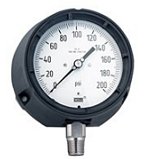AMAZON multi-meters discounts AMAZON oscilloscope discounts
 The
Bourdon Tube is one of the most common pressure sensors in use. The simplest
form of this sensor is made of a C-shaped metal tube. One end of the tube
is sealed, and the other end is connected to the source of pressure that
is being measured. The end that pressure is applied to is mounted in such
a way that it can't move. When pressure is applied to the inside of the
tube, the sealed end of the tube will tend to straighten out, which will
cause a small amount of movement at the sealed end of the tube. This movement
can be amplified directly by gears and a pointer to make a direct-reading
pressure gauge. Or the movement can be transferred to a linear potentiometer,
which would let the signal convert pressure to a change of resistance.
The potentiometer can be part of a bridge circuit so that the output signal
can be represented by a change of voltage. The image on the left is a
typical Bourdon tube sensor used in a pressure gauge.
The
Bourdon Tube is one of the most common pressure sensors in use. The simplest
form of this sensor is made of a C-shaped metal tube. One end of the tube
is sealed, and the other end is connected to the source of pressure that
is being measured. The end that pressure is applied to is mounted in such
a way that it can't move. When pressure is applied to the inside of the
tube, the sealed end of the tube will tend to straighten out, which will
cause a small amount of movement at the sealed end of the tube. This movement
can be amplified directly by gears and a pointer to make a direct-reading
pressure gauge. Or the movement can be transferred to a linear potentiometer,
which would let the signal convert pressure to a change of resistance.
The potentiometer can be part of a bridge circuit so that the output signal
can be represented by a change of voltage. The image on the left is a
typical Bourdon tube sensor used in a pressure gauge.
The shape of the Bourdon tube can be modified so that a small amount of pressure will cause the tube to move farther. One modification involves bending the tube into a series of spirals and the second involves bending the tube into a helix. The images below shows examples of the spiral-type and helix-type Bourdon tube. The end of the spiral-type Bourdon tube will tend to move farther when pressure is applied since there is more tube exposed to the pressure. The helix is designed so that a long piece of tubing is flattened slightly and rolled into a series of continuous loops. The open end of the helix is firmly held in place and the sealed end is connected to a center shaft. When pressure is applied to the helix, the entire length of the tubing tries to open or unwind around the shaft, which causes the shaft to rotate. This motion can be connected to a pointer to provide a direct reading or to a potentiometer so that the amount of pressure can be converted to a change of voltage.
above: Example of a helix-type Bourdon tube. |
above: Example of a spiral-type Bourdon tube. |
Bourdon tube sensors are used to measure pressure up to 100,000 psi. They are not useful for low pressures under 15 psi because the tubing is rigid and the amount of movement of the open end of the tube is very small. These types of sensors are used in pressure gauges that can indicate the amount of hydraulic or steam pressure. e.g., a plastic injection molding machine will have several hydraulic gauges to indicate the amount of pressure the system uses to inject plastic into a mold, or the pressure that is available at the hydraulic pump.
Advantages
of Bourdon Tube Pressure Sensors |
Disadvantages
of Bourdon Tube Pressure Sensor |
|
|
Prev. Page: Vacuum Sensors | Next Page: Diaphragm Pressure Sensor
Related pages: Load Cells | Flow Meters